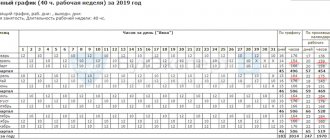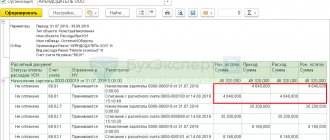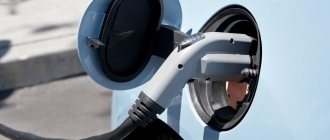How are regulations regulated?
A vehicle requires fuel to operate. Each category of car requires different volumes of fuel and lubricants. The Ministry of Transport has developed a special standard - this is the fuel consumption rate for car brands. The standard allows you to determine how much fuel and lubricants a specific brand of vehicle requires to support the technological process. The standards are developed only in relation to the operating process of vehicles. For example, it is unacceptable to use values to calculate the write-off of fuel and lubricants during repair, adjustment or testing. For technological purposes, additional fuel consumption standards (FLC) should be established.
The Ministry of Transport introduced the standards by a separate Order No. AM-23-r dated March 14, 2008 (as amended on September 20, 2018). The document establishes several categories of standards for fuel and fuel consumption:
- Basic standard for gasoline consumption in liters per 100 km in running order.
- Transport standard in liters per 100 km in operation (during transport work), including:
- cost standard for a bus taking into account curb weight and nominal passenger load;
- consumption standard for dump trucks, taking into account equipment and nominal vehicle load.
- Transport standard for a truck in liters per 100 ton-kilometers, determined during transport work.
Standards are set in liters, for example, for gasoline or diesel fuel. Or the standards are fixed in cubic meters if, for example, transport consumes gas.
How else can the fuel consumption rate for gas be set?
The given standards of the Ministry of Transport are mandatory for use by motor transport enterprises and organizations of management and control systems, and for other business entities (companies and individual entrepreneurs) these standards are advisory in nature. This also follows from letters of the Federal Tax Service of Russia dated 06/03/2013 No. 03-03-06/1/20097 and the Ministry of Finance dated 01/30/2013 No. 03-03-06/2/12. Currently, enterprises are not required to use the standards established by the Consumption Standards of the Ministry of Transport, therefore the following options for establishing standards for the write-off of gas fuel are possible:
- use the standards specified in the technical documentation of the vehicle or gas equipment manufacturer;
- contact scientific organizations that develop individual fuel consumption standards for a specific type of transport (in the absence of standards approved by the Ministry of Transport);
- develop standards yourself using control measurements.
Consumption rates must be approved by the company’s internal administrative document.
Read also: Gasoline (fuel and lubricants) accounting
Currently, judicial practice is beginning to emerge, which suggests that organizations may not use any standards for fuel at all and write it off according to actual consumption. But such costs cannot be taken into account when calculating income tax, since Article 252 of the Tax Code of the Russian Federation requires justification of all costs that reduce the tax base.
Read also: fuels and lubricants and income tax
Is it possible to develop individual standards?
Whether or not to use the standards of the Ministry of Transport in your work is the decision of the company’s management. That is, at the legislative level there are no requirements for the mandatory use of NRT.
The Tax Code does not require standardization of costs for fuels and lubricants either according to the corporate income tax or under the simplified tax system. A similar position is supported by the Ministry of Finance (Letters dated March 22, 2019 No. 03-03-07/19283, dated September 27, 2018 No. 03-11-11/69335). Each organization must make its own decision about working with fuel standards.
Cost standards are allowed to be developed independently. For example, an institution, based on the recommendation of the Ministry of Transport, approves its own standards. The indicators correspond to the real characteristics of vehicles used in the process of life.
The ministry's recommendations are just standard values calculated based on the general characteristics of car brands. Despite the correction factors, in practice the values differ significantly from the actual costs. Therefore, organizations have the right to approve their own indicators.
Approve standard values by local order.
How to count
Officials identified three main concepts:
| Basic NRT | This is the standard cost of fuel and lubricants. Installed separately for each brand of vehicle. Takes into account individual designs, curb weight, type of fuel consumed and other characteristics. The type of flow is applicable for standard, typified situations. |
| Transport NZT | This type of regulatory use is applied taking into account the characteristics of the transport operation of the unit. In essence, this is a basic standard, recalculated taking into account the carrying capacity, towing force, and the rated load of cargo or passengers. That is, a standard taking into account the performance characteristics of the car. |
| Operational NRT | This is a real cost standard, which is recalculated taking into account correction factors. These are basic and transport NRT, which take into account the operating conditions of the vehicle (terrain, climate, temperature conditions and other operating features). |
Each of the standard values is recalculated in relation to the base value, taking into account correction factors. A detailed table of fuel consumption standards for 2022 reveals values by car brand. Abbreviations in the table:
- B - gasoline;
- D - diesel fuel;
- LPG - liquefied petroleum gas;
- CNG is compressed natural gas.
| Model, brand, modification of the car | Basic rate, l/100 km | Type of fuel |
| VAZ-1111 "Oka" | 6,5 | B |
| VAZ-11113 "Oka" (VAZ-11113-2L-0.75-35-4M) | 5,6 | B |
| VAZ-11183 "Kalina" (VAZ-21114-4L-1,596-81-5M) | 8,0 | B |
| VAZ-2104 | 8,5 | B |
| VAZ-21041 (VAZ-21067.10-4L-1,568-74,5-5M) | 9,1 | B |
| VAZ-21043 (VAZ-2103-4L-1.45-71-5M) | 8,3 | B |
| VAZ-21043 (VAZ-2103-4L-1,451-71,5-4M) | 9,0 | B |
| VAZ-2105, -21051, -21053 | 8,5 | B |
| VAZ-2106 (VAZ-2106-4L-1.57-75.5-5M) | 8,5 | B |
| VAZ-2106 (VAZ-2106-4L-1.57-75.5-4M) | 9,0 | B |
| VAZ-21061 | 9,0 | B |
| VAZ-21063 (VAZ-2130-4L-1.77-82-5M) | 9,0 | B |
| VAZ-2107 (VAZ-2103-4L-1.45-72.5-4M) | 8,6 | B |
| VAZ-21072 (VAZ-2105-4L-1.3-63.5-4M) | 8,9 | B |
| VAZ-21074 (VAZ-2106-4L-1.57-75.5-5M) | 8,5 | B |
| VAZ-21074 (VAZ-21067-4L-1,568-74,5-5M) | 8,9 | B |
| VAZ-2108, -2108 “Sputnik”, -21081, -21083, -2109 | 8,0 | B |
| VAZ-21093 (VAZ-2111-4L-1,499-79-5M) | 7,7 | B |
| VAZ-21093; -21099 1.5i (VAZ-21083-20-4L-1.5-71-5M) | 7,5 | B |
| VAZ-21099 (VAZ-2111-4L-1,499-79-5M) | 7,8 | B |
| VAZ-2110 1.5i (VAZ-21083-20-4L-1.5-71-5M) | 7,4 | B |
| VAZ-2110-010 (VAZ-2110-4L-1,499-73-5M) | 7,8 | B |
| VAZ-21102 (VAZ-2111-4L-1,499-79-5M) | 7,5 | B |
| VAZ-21103 (VAZ-2112-4L-1,499-92-5M) | 7,7 | B |
| VAZ-21104 (VAZ-21124-4L-1,596-90-5M) | 8,4 | B |
| VAZ-2111 (VAZ-2111-4L-1,499-79-5M) | 7,6 | B |
| VAZ-21112-00 1.6 (VAZ-21114-4L-1,596-80-5M) | 8,3 | B |
| VAZ-21113 (VAZ-2112-4L-1,499-92-5M) | 7,8 | B |
| VAZ-2112 (VAZ-2112-4L-1,499-92-5M) | 7,7 | B |
| VAZ-21140 (VAZ-2111-4L-1,499-79-5M) | 7,9 | B |
| VAZ-21150 (VAZ-2111-4L-1,499-79-3,94-5M) | 7,4 | B |
| VAZ-2120 (VAZ-2130-4L-1,774-82-5M) | 10,7 | B |
| VAZ-212090 "Bronto" armor. (VAZ-2130-4L-1,774-82-5M) | 12,5 | B |
| VAZ-2121, -21211 | 12,0 | B |
| VAZ-21213 (VAZ-21213-4L-1,690-80-5M) | 11,5 | B |
| VAZ-21213B armor. (VAZ-21213-4L-1.69-79-5M) | 12,1 | B |
| VAZ-21214-20 “Chevrolet Niva” (VAZ-21214.10-4L-1,689-82-5M) | 10,9 | B |
| VAZ-21218 (VAZ-21213-4L-1.69-79-5M) | 11,9 | B |
| VAZ-212182 armored (VAZ-21213-4L-1.69-79-5M) | 12,3 | B |
| VAZ-212300 "Chevrolet Niva" (VAZ-2123-4L-1.69-80-5M) | 10,5 | B |
| VAZ-2131 (VAZ-21213-4L-1.69-80-5M) | 11,3 | B |
| VAZ-21310 (VAZ-2130-4L-1,774-82-5M) | 11,5 | B |
| VAZ-213102 "Bronto" armor. (VAZ-2130-4L-1,774-80-5M) | 12,4 | B |
| VAZ-21312 (VAZ-2130-4L-1,774-82-5M) | 11,4 | B |
| VAZ-2302 “Bison” (VAZ-2121-4L-1.57-78-4M) | 11,5 | B |
| GAZ-13 | 20,0 | B |
| GAZ-14 | 22,0 | B |
| GAZ-24, -24-10, -24-60 | 13,0 | B |
| GAZ-24-01, -24-03, -24-11, -24-14, -24T | 13,5 | B |
| GAZ-24-02, -24-04 | 14,0 | B |
| GAZ-24-07 | 16,5 | CIS |
| GAZ-24-12, -24-13 (with engine ZMZ-402, -402.10) | 13,5 | B |
| GAZ-24-12, -24-13 (with engine ZMZ-4021, -4021.10) | 14,0 | B |
| GAZ-24-17, -24-25 | 16,5 | CIS |
| GAZ-3102 (with engine ZMZ-4022.10) | 13,0 | B |
| GAZ-3102 (Chrysler-4L-2,429-137-5M) | 10,7 | B |
| GAZ-3102 (Toyota 3RZ-FE-4L-2,694-152-5M) | 11,2 | B |
| GAZ-3102, -3102-12 (ZMZ-4062.10-4L-2.3-150-4M) | 12,5 | B |
| GAZ-3102-12; GAZ-3102 (ZMZ-4062.10-4L-2.3-150-5M) | 12,0 | B |
| GAZ-310200 (Toyota-6V-3,378-194-4A) | 13,8 | B |
| GAZ-310200 (Rover-8V-3.95-182-5M) | 13,5 | B |
| GAZ-31022 (ZMZ-4021.10-4L-2,445-90-4M) | 13,9 | B |
| GAZ-310221 (ZMZ-40210D-4L-2,445-81-5M) | 13,1 | B |
| GAZ-310221 (ZMZ-40620D-4L-2.3-131-5M) | 11,5 | B |
| GAZ-31029 (Rover-4L-1,994-140-5M) | 11,5 | B |
| GAZ-31029 (ZMZ-402; 402.10 - 4L-2,445-100-4M) | 13,0 | B |
| GAZ-31029 (ZMZ-4021; 4021.10 - 4L-2,445-90-4M) | 13,5 | B |
| GAZ-3105 (8V-3.4-170-5M) | 13,7 | B |
| GAZ-3110 (ZMZ-4026.10; -40200F-4L-2,445-100-4M) | 13,0 | B |
| GAZ-3110 (Rover-4L-1,996-136-5M) | 10,7 | B |
| GAZ-3110 (ZMZ-4020 OM-4L-2,445-100-5M) | 12,2 | B |
| GAZ-3110 (ZMZ-4062.10-4L-2,287-150-5M) | 11,4 | B |
| GAZ-3110 (ZMZ-40210D; -4021-4L-2,445-90-5M) | 13,0 | B |
| GAZ-3110 (ZMZ-4026.10; -402-4L-2,445-100-5M) | 12,1 | B |
| GAZ-3110 (ZMZ-40620D-4L-2.3-131-5M) | 11,5 | B |
| GAZ-3110-551 (Chrysler-4L-2,429-137-5M) | 10,6 | B |
| GAZ-31105 (ZMZ-40620D-4L-2.3-131-5M) | 11,5 | B |
| ZAZ-1102 | 7,0 | B |
| ZIL-114 | 24,0 | B |
| ZIL-117 | 23,0 | B |
| ZIL-4104 | 26,0 | B |
| ZIL-41047 (8V-7.68-315-3A) | 26,5 | B |
| IZH-2125, -21251, -2126 | 10,0 | B |
| LuAZ-1302 | 11 | B |
| Moskvich-2136, -2140, -2141 (all modifications) | 10,0 | B |
| Moskvich-2141 “Yuri Dolgoruky” (Renault-4L-1,998-113-5M) | 8,6 | B |
| Moskvich-2141-22 (UZAM-3317-4L-1.7-85-5M) | 9,4 | B |
| Moskvich-2141-22 (UZAM-3320-4L-2.0-91-5M) | 9,6 | B |
| Moskvich-21412-01 (UZAM-331.10-4L-1,478-72-5M) | 8,5 | B |
| Moskvich-21412-01 (UZAM-3313-4L-1,815-85-5M) | 9,0 | B |
| Moskvich-214145 “Svyatogor” (Renault-4L-1,998-113-5M) | 8,8 | B |
| Moskvich-2142 “Prince Vladimir” (Renault-4L-1,988-113-5M) | 8,9 | B |
| Moskvich-2142 “Ivan Kalita” (Renault-4L-1,988-145-5M) | 10,2 | B |
| UAZ-31512 (ZMZ-4025.10-4L-2.45-90-4M) | 15,5 | B |
| UAZ-31512 (ZMZ-40260F-4L-2,445-100-4M) | 15,4 | B |
| UAZ-31512 (UMZ-4178-4L-2,445-76-4M) | 15,1 | B |
| UAZ-31514 (ZMZ-4025.10-4L-2,445-90-4M) | 16,7 | B |
| UAZ-31514 (ZMZ-40210L-4L-2,445-81-4M) | 15,5 | B |
| UAZ-31514 (UMZ-41780V-4L-2,445-76-4M) | 15,8 | B |
| UAZ-31514 (UMZ-402100-4L-2,445-74-4M) | 15,6 | B |
| UAZ-31517 (HR 492 NTA -4L-2,393-100-4M) | 11,0 | D |
| UAZ-31519 (UMZ-4218.10-4L-2.89-98-4M) | 14,5 | B |
| UAZ-31519 (UMZ-4218-4L-2.89-84-4M) | 15,9 | B |
| UAZ-31519 (UMZ-4218-4L-2.89-98-4M) | 14,9 | B |
| UAZ-315195 (ZMZ-4090011-4L-2,693-128-5M) | 13,5 | B |
| UAZ-315195 Hunter (ZMZ-40900G-4L-2,693-128-4M) | 13,8 | B |
| UAZ-3153 SBA-4UM (armored) (UMZ-4218-10 -4L-2.89-98-4M) | 16,6 | B |
| UAZ-3153 (UMZ-4218-4L-2.89-84-4M) | 15,4 | B |
| UAZ-3159 “Bars” (ZMZ-4092.10-4L-2.7-133-5M) | 16,5 | B |
| UAZ-31601 (UMZ-421.10-10-4L-2.89-98-5M) | 15,3 | B |
| UAZ-31604 (VM-425LTRV-4L-2.5-105-5M) | 13,2 | D |
| UAZ-3162 SBA 10U (armored) (UMZ-421.10-4L-2.89-98-4M) | 16,0 | B |
| UAZ-31622 (ZMZ-4092.10-4L-2.69-130-5M) | 13,7 | B |
| UAZ-3163-10 “Patriot” (ZMZ-40900R-4L-2,693-128-5M) | 13,5 | B |
Calculation for passenger cars
For a passenger car, the standard is calculated using a special formula:
Qн = 0.01 × Hs × S × (1 + 0.01 × D),
Where:
- Qn is the fuel cost standard, calculated in liters;
- Hs is the basic standard of fuel consumption for a vehicle mileage of 100 km;
- S - specific mileage of the car, calculated in km;
- D - correction factor set to the standard, reflected in %.
The basic standard is determined in accordance with the recommendations of the table of standards for write-off of fuel and lubricants of the Ministry of Transport. For example, separate values are provided:
- for domestic transport until 2014;
- for foreign cars before 2008;
- for foreign brands from 2008 to 2014.
IMPORTANT!
Mileage accounting for calculating standard values is carried out exclusively on waybills. This is a special primary document required to be completed by organizations operating transport. Read about the form and rules for filling it out in the article “Instructions: filling out the waybill for a passenger car.”
Reasons for high gas consumption
If fuel consumption differs from the passport values by more than 30%, you need to go for diagnostics. There may be several reasons for increased fuel costs:
- Incorrect, too harsh driving style, with sharp braking and instant acceleration.
- Poor quality gasoline.
- Poor performance of the power unit and its components.
- Negative temperatures, driving on winter roads.
- Constant operation of the heater, air conditioner and other devices in the cabin.
If you operate the car correctly, you can get as close as possible to the indicators that are in the documents.
Calculation for buses
If the company operates buses in operation, then the standards will have to be calculated differently. To do this, use the following formula:
Qn = 0.01 × Hs × S × (1 + 0.01 × D) + Hot × T,
Where:
- Qн is the fuel and lubricants cost standard, calculated in liters;
- Hs - transport NT consumption, determined for a bus mileage of 100 km, calculated taking into account the passenger load normalized by class and purpose of the bus;
- S is the actual mileage of the bus, determined in km according to the waybill;
- Hoth - standard fuel and lubricant costs for the operation of standard independent heaters, calculated in l/h;
- T — actual operating time of the bus with the heater on, h;
- D—correction factor determined to the standard, %.
The actual mileage of the bus is confirmed by the waybill.
Calculation for trucks
For freight vehicles, the calculation procedure is more complicated. The calculation takes into account the weight of the cargo, the weight of the trailers, and other transportation characteristics. For dump trucks and tractors, standard values are calculated in a special order.
Formula for calculating the fuel consumption rate for a truck:
Qн = 0.01 × (Hsan × S + Hw × W) × (1 + 0.01 × D),
Where:
- Qn - standard fuel consumption in liters;
- S - mileage of a car or road train, determined in km;
- Hsan is the fuel consumption rate established for the mileage of a car or road train in running order without load.
The last Hsan indicator is calculated separately. To do this, use the formula:
Hsan = Hs + Hg × Gpr, l/100 km,
Where:
- Hs is the basic fuel consumption rate for the mileage of a car (tractor) in running order, l/100 km (Hsan = Hs, l/100 km, for a single car, tractor);
- Hg - fuel consumption rate for the additional weight of a trailer or semi-trailer, l/100 t. km;
- Gpr - trailer or semi-trailer own weight, t;
- Hw—fuel consumption rate for transport work, l/100 t. km;
- W is the volume of transport work, t. km: W = Ggr × Sgr (where Ggr is the mass of the cargo, t, Sgr is the mileage with the cargo, km);
- D — correction factor (total relative increase or decrease) to the norm, %.
Determine the actual mileage using the waybill. Details are in the article “Filling out a new waybill for a truck.”
Basic fuel and lubricant costs - the amount recommended by the Ministry of Transport in 2022
The basic standard sets the amount of fuel that a vehicle consumes per hundred kilometers. The base calculation is based on data about the design of the transport unit, its purpose, curb weight, type of fuel and other data.
The basic one must be adjusted taking into account the following factors:
seasonality (consumption increases in winter); altitude above sea level where the vehicle is used (for high mountain roads, for example, 20% higher); quality of roads (many factors are taken into account, including the number of turns); age of the vehicle (the older, the higher the consumption); other.
Adjustment factors
Standard recalculation of standards does not provide actual indicators. Officials introduced a special correction factor to the fuel consumption rate. There are several correction values at once. They are installed depending on numerous factors of transport operation. The coefficients both increase and decrease the standards.
For example, when operating in winter, vehicles consume more fuel than in the summer months. At the same time, when driving on an open highway, the car consumes less fuel than, for example, when driving around the city or on a dangerous road section.
From what date do winter standards apply?
When the temperature drops below +5 °C, a winter supplement is applied, the duration of which depends on the region. There is no single standard for the date on which the transition to winter fuel consumption standards in 2022 by region will take place this winter. The transition is carried out depending on the climate zone. Both winter and summer fuel consumption standards depend on the climate of the place of operation - from which month they are introduced. In the central part of Russia, the winter premium is up to 10% and is introduced for five months: from November 1 to March 31. In the northern regions, the premium reaches 20% and applies up to 7 months a year.
The table shows winter fuel consumption rates by region in 2021:
| Subject of the Russian Federation or part thereof | Number of months and period from which to which winter period for cars in the region | Maximum amount of winter allowances, no more, % |
| Moscow | 5 01.11–31.03 | 10 |
| Belgorod region | 4 15.11–15.03 | 7 |
| Bryansk region | 5 01.11–31.03 | 10 |
| Vladimir region | 5 01.11–31.03 | 10 |
| Voronezh region | 5 01.11–31.03 | 10 |
| Ivanovo region | 5 01.11–31.03 | 10 |
| Kaluga region | 5 01.11–31.03 | 10 |
| Kostroma region | 5 01.11–31.03 | 10 |
| Kursk region | 5 01.11–31.03 | 10 |
| Lipetsk region | 5 01.11–31.03 | 10 |
A complete list of winter fuel consumption standards and the timing of their application in 2021 by climatic zone is presented in Appendix 2 to the methodological recommendations for establishing fuel consumption standards.
To switch to winter coefficients, it is recommended to issue an order.
When standards rise
There are quite a lot of reasons for using increasing factors to calculate fuel consumption rates in road transport. The coefficient values vary from 5% to 50%. And in total they give much larger values.
Reasons for increasing fuel consumption standards:
- work in winter - 5-20%;
- operation in mountainous areas - 5-20%;
- complex roads and dangerous sections of roads - 10-30%;
- movement in urban areas - 5-35%;
- the need for frequent technological stops - 10%;
- the need for low speed - 15-35% on average;
- for running in a new car - up to 10%;
- by duration of operation - 5-10%.
These are just the key factors that increase fuel consumption. An exhaustive list is given in Order of the Ministry of Transport of Russia dated March 14, 2008 No. AM-23-r (as amended on September 20, 2018).
Assessment and examination No. 1 |
ABO LLC EXPERTS WILL PREPARATE REPORTS AND CONCLUSIONS OF ANY COMPLEXITY, FOR ANY PURPOSE!
- Barnaul
- — Biysk
- - Rubtsovsk
- Novosibirsk
- Our partners:
- Moscow
- Saint Petersburg
- Vladivostok
- Volgograd
- Voronezh
- Gorno-Altaisk
- Ekaterinburg
- Irkutsk
- Kazan
- Kaliningrad
- Kemerovo
- Korolev
- Krasnodar
- Krasnoyarsk
- Nizhnevartovsk
- Nizhny Novgorod
- Omsk
- Permian
- Rostov-on-Don
- Samara
- Tomsk
- Ufa
- Chelyabinsk
More than 9 years on the market. Your own staff of experts. Over 6,500 conclusions and reports. Call us, 8-903-947-6150
Expertise and calculation of fuel consumption rates (fuel and lubricants) for cars and special equipment
Experts from ABO LLC calculate vehicle fuel consumption rates and issue a conclusion. Do you have any questions? Call! tel., 8-903-947-6150!
This service can be provided remotely, with free delivery in the city or region.
Due to the unfavorable epidemiological situation associated with covid-19, we began to provide a number of services through remote work, without visiting the office. To find out more, click “more details”
.
The fuel consumption rate for cars is the maximum permissible amount of fuel that a car can consume to cover a certain distance.
“Car fuel consumption” is one of the important economic characteristics of a car. The issue of monitoring fuel consumption (fuel consumption) is acute in many organizations. Often the questions are related to fuel theft. The consumption rate of fuels and lubricants in relation to road transport implies a set value for the measure of its consumption when operating a vehicle of a specific model, brand or modification. The consumption standards for fuels and lubricants in road transport are intended for calculating the standard value of fuel consumption at the point of consumption, for maintaining statistical and operational reporting, determining the cost of transportation and other types of transport work, planning the needs of enterprises for the supply of petroleum products, for calculating the taxation of enterprises, implementing mode of economy and energy conservation of consumed petroleum products, settlements with vehicle users, drivers, etc.
An example of the conclusions of an examination of the fuel consumption rate (fuel consumption) of a car
Sample conclusions calculating fuel consumption rates for cars
Sample expert opinion on determining the fuel consumption rate of a Mazda CX-5 car
When normalizing fuel consumption, a distinction is made between the basic value of fuel consumption, which is determined for each model, brand or modification of a car as a generally accepted norm, and the calculated standard value of fuel consumption, which takes into account the transport work being performed and the operating conditions of the vehicle. Calculation of vehicle fuel consumption rates (fuel consumption timing) is determined for each model and brand, depending on the type of vehicle, volume and type of engine, etc.
Fuel consumption rates are calculated in accordance with the Order of the Ministry of Transport of Russia dated March 14, 2008 N AM-23-r (as amended on September 20, 2018) “On the implementation of methodological recommendations “Consumption standards for fuels and lubricants in road transport.”
Fuel consumption standards can be established for each model, brand and modification of vehicles in use and correspond to certain operating conditions of motor vehicles according to their classification and purpose. The standards include the fuel consumption required for the transport process. Fuel consumption for technical, garage and other internal economic needs not directly related to the technological process of transporting passengers and cargo is not included in the standards (in the tables) and is established separately.
The following types of norms have been established for cars: (as amended by the order of the Ministry of Transport of Russia dated July 14, 2015 N) - the basic norm in liters per 100 km (l/100 km) of mileage of a motor vehicle (ATS) when equipped - the transport norm in liters per 100 km (l/100 km) mileage during transport work; — operating rate in liters per 100 km (l/100 km) of mileage when carrying out transport work in a specific area.
The basic fuel consumption rate depends on the design of the car, its units and systems, the category, type and purpose of the automobile rolling stock (passenger cars, buses, trucks, etc.), on the type of fuel used, takes into account the weight of the car in running order, the typed route and driving mode under operating conditions within the limits of the “Road Rules”.
The transport standard (standard for transport work) includes the basic standard and depends either on the carrying capacity, or on the standardized load of passengers, or on the specific weight of the cargo being transported. The operating standard is established at the place of operation of the vehicle on the basis of the basic or transport standard using correction factors (surcharges) that take into account local operating conditions.
Fuel consumption standards per 100 km of vehicle mileage are set in the following measurements: - for gasoline and diesel vehicles - in liters of gasoline or diesel fuel; — for vehicles running on liquefied petroleum gas (LPG), — in liters
LPG at the rate of 1 liter of gasoline corresponds to “1.32 liters of LPG, no more” (the recommended rate is within 1.22 +/- 0.10 liters of LPG to 1 liter of gasoline, depending on the properties of the propane-butane mixture); - for vehicles running on compressed natural gas (CNG) - in normal meters - cubic LNG, at the rate of 1 liter of gasoline corresponds to 1 +/- 0.1 cubic meters. m of CNG (depending on the properties of natural gas. - for gas-diesel vehicles, the consumption rate of compressed natural gas is indicated in cubic meters, while simultaneously indicating the diesel fuel consumption rate in liters, their ratio is determined by the manufacturer of the equipment (or in the operating instructions).
Accounting for road transport, climatic and other operational factors is carried out using correction factors (surcharges), regulated in the form of percentage increases or decreases in the initial value of the norm (their values are established by decision of the legal entity or individual entrepreneur operating the vehicle).
Fuel consumption rates increase under the following conditions: Operation of vehicles in the winter season, depending on the climatic regions of the country - from 5% to 20% Operation of vehicles on public roads (I, II and III categories) in mountainous areas, including cities, towns and suburban areas, at altitude above sea level: from 300 to 800 m - up to 5% (lower mountains); from 801 to 2000 m - up to 10% (mid-mountain); from 2001 to 3000 m - up to 15% (highlands); over 3000 m - up to 20% (high mountains). Operation of vehicles on public roads of categories I, II and III with a complex layout (outside cities and suburban areas), where on average there are more than five curves (turns) with a radius of less than 40 m per 1 km of road (or per 100 km of road - about 500) - up to 10%, on public roads of categories IV and V - up to 30%. When operating vehicles in populated areas with a population of: over 5 million people - up to 35%; from 1 to 5 million people - up to 25%, from 250 thousand to 1 million people - up to 15%; from 100 to 250 thousand people - up to 10%, up to 100 thousand people (in the presence of controlled intersections, traffic lights or other traffic signs) - up to 5%. Operation of vehicles requiring frequent technological stops associated with loading and unloading, boarding and disembarking passengers, including route taxis, buses, cargo-passenger and small-class trucks, pickup trucks, station wagons, etc., including transportation of products and small cargo, servicing mailboxes, cash collection, servicing pensioners, disabled people, sick people, etc. (if there is an average of more than one stop per 1 km; stops at traffic lights, intersections and crossings are not taken into account) - up to 10%.
When vehicles move at a reduced average speed (when transporting non-standard, large, heavy, dangerous goods, cargo in glass and other similar goods, when moving in convoys when the vehicle is accompanied by cover vehicles) in the range of 20 - 40 km/h - up to 15% , the same with an average speed below 20 km/h - up to 35%. When running in new cars and those that have undergone major repairs (mileage is determined by the vehicle manufacturer) - up to 10%. In the case of centralized transportation of cars under their own power in a single state or in a convoy - up to 10%; when hauling and towing vehicles in a paired state - up to 15%; when hauling and towing in a assembled state - up to 20%. For cars that have been in operation for more than five years or with a total mileage of more than 100 thousand km - up to 5%; more than eight years or with a total mileage of more than 150 thousand km - up to 10%. When operating trucks, vans, cargo taxis, etc. excluding transport work - up to 10%.
When cars operate as technological transport, including work inside an enterprise, up to 20%.
During the operation of special vehicles (patrol vehicles, film cameras, firefighters, ambulances, photo and video recording vehicles, repair vehicles, aerial platforms, forklifts, etc.) performing the transport process when maneuvering, at low speeds, with frequent stops, reversing, etc. P. - up to 20%. When working in quarries (except for special quarry vehicles), when moving across the field, when hauling timber, etc. on horizontal sections of roads of categories IV and V: for vehicles in running order without cargo - up to 20%, for vehicles with a full or partial vehicle load - up to 40%. When working in extreme climatic and severe road conditions during seasonal thaw, snow or sand drifts, heavy snowfall and ice, floods, forest fires and other natural disasters for roads of I, II and III categories - up to 35%, for roads IV and V categories - up to 50%. When driving for training on public roads - up to 20%; during training driving on specially designated training areas, when maneuvering at low speeds, with frequent stops and reversing - up to 40%. When using the climate control setting (regardless of the time of year) when the car is moving - up to 7%. When using the air conditioner while driving the car - up to 7% (the use of this coefficient together with the winter surcharge depending on the climatic regions is not allowed). Fuel consumption standards for the operation of additional equipment of refrigerators, buses, special and specialized vehicles are determined by scientific organizations involved in the development of such standards, by manufacturers of additional equipment or vehicles (standardized in l/hour). When using an air conditioner in a parking lot, the standard fuel consumption is set based on one hour of inactivity with the engine running, the same in the parking lot when using the climate control installation (regardless of the time of year) for one hour of inactivity with the engine running - up to 10% of the base norms. When vehicles are idle for loading or unloading at points where, according to safety conditions or other applicable rules, it is prohibited to turn off the engine (oil depots, special warehouses, the presence of cargo that does not allow cooling of the body, banks and other objects), as well as in other cases of forced idle time of the vehicle with with the engine turned on - up to 10% of the base rate for one hour of inactivity.
During the winter or cold season (with an average daily temperature below +5 °C) in parking lots when it is necessary to start and warm up cars and buses (if there are no independent heaters), as well as in parking lots waiting for passengers (including for medical vehicles and when transporting children ) standard fuel consumption is established based on one hour of parking (idle) with the engine running - up to 10% of the basic norm.
It is allowed, on the basis of a decision of a legal entity or individual entrepreneur operating a vehicle: - for intra-garage travel and technical needs of motor transport enterprises (technical inspections, adjustment work, running-in of engine parts and other vehicle components after repair, etc.) to increase the standard fuel consumption to 1% of the total quantity consumed by this enterprise (with justification and taking into account the actual number of vehicles used in these works); — for brands and modifications of cars that do not have significant design changes compared to the base model (with the same technical characteristics of the engine, gearbox, final drive, tires, wheel arrangement, body) and do not differ from the base model in curb weight, set a basic consumption rate fuels in the same sizes as for the base model; - for brands and modifications of cars that do not have the design changes listed above, but differ from the base model only in their own weight (when installing vans, kungs, awnings, additional equipment, armor, etc.), fuel consumption rates can be determined: for each a ton of increase (decrease) in the vehicle's own weight with an increase (decrease) at the rate of up to 2 l/100 km for cars with gasoline engines, at the rate of up to 1.3 l/100 km - with diesel engines, at the rate of up to 2.64 l/ 100 km for vehicles running on liquefied gas, based on up to 2 cubic meters. m/100 km for vehicles running on compressed natural gas; with a gas-diesel engine process, approximately up to 1.2 cubic meters. m of natural gas and up to 0.25 l/100 km of diesel fuel, based on each ton of change in the vehicle’s own weight. Fuel consumption rates may decrease.







